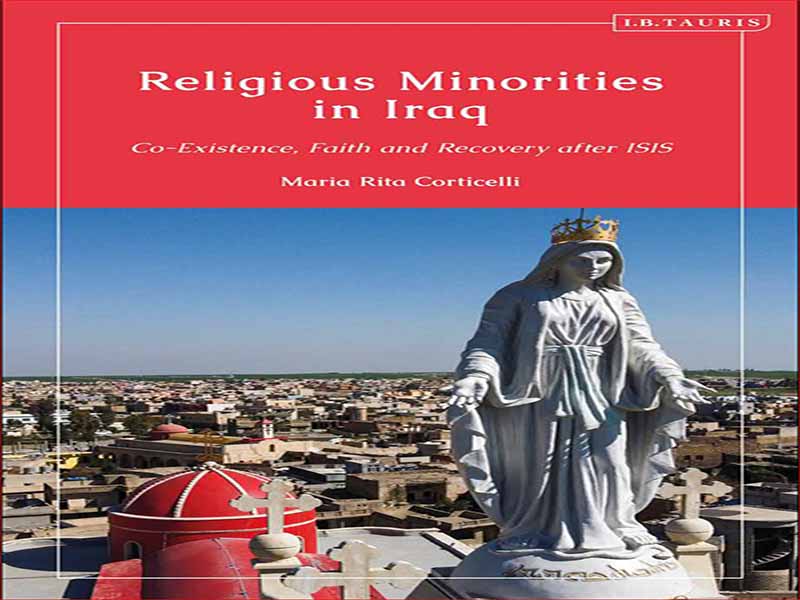- عنوان کتاب: Religious Minorities in Iraq
- نویسنده: Maria Rita Corticelli
- حوزه: اقلیت های مذهبی
- سال انتشار: 2022
- تعداد صفحه: 217
- زبان اصلی: انگلیسی
- نوع فایل: pdf
- حجم فایل: 1.36 مگابایت
ادبیات مربوط به جوامع مذهبی در عراق معمولاً از نگرش فرقهای مشابهی رنج میبرد که بر بخشهایی از جامعه عراق تأثیر میگذارد: غربیها به طور کلی تمایل دارند با آنها در انزوا رفتار کنند، گویی مسیحیان، کاکاییها، ایزدیها و سایر جوامع در داخل محفظههای ضدآب بسته شدهاند. تعامل بین آنها دو سال کار تحقیقاتی انجام شده بین سالهای 2016 و 2018 نشان میدهد که واقعیت روی زمین بسیار متفاوت است. بدون به خطر انداختن غنای ناگزیر از تنوع، همه این گروهها به شیوهای بسیار پویا با هم تعامل دارند و با همان میل به جامعهای جدید و بردبارتر متحرک میشوند. هدف این کتاب نشان دادن خلأهای به جا مانده از رسانه ها و دانشگاه ها با یک کار تحقیقاتی ظریف تر و عمیق تر در مورد نحوه زندگی جوامع و مقابله با ارعاب های گذشته و حال است. به قول خودشان، اعضای این جوامع داستان هایی از مقاومت در برابر ظلم، خلاقیت در تاریک ترین لحظات، امید در میان مرگ، تایید نهایی ایمان به زندگی در برابر خشونت را روایت می کنند. همه آنها اکنون در تلاشی مشترک و تقریباً قهرمانانه برای بازسازی و ساختن صلح با هم متحد شده اند، که تحقق آن بدون گفتگوی تازه بین ادیان غیرممکن است. در بیش از دو سال، من با بیش از صد نفر بین نمایندگان جوامع مذهبی، دانشگاهیان، فعالان، سیاستمداران، سیاست گذاران، شهروندان و پناهندگان مصاحبه کرده ام. در میان آنها قربانیان و مجرمان، مردان، زنان و کودکان بودند که غرق حوادث تلخ چند سال گذشته شده اند. از طریق روایتهای این اقلیتهای مذهبی و مکانهای باستانشناختی، به دورافتادهترین روستاهای بینالنهرین سفر کردم تا دریابم چگونه بعد از قرنها، صومعهها و کلیساهای مسیحی هنوز هم ریتم روستاهای ویران شده توسط دولت اسلامی عراق و سوریه را نشان میدهند. (داعش) و اکنون فقط تا حدی بازسازی شده است. و از اماکن مقدس کاکائی ها در کوه های زاگرس دیدن کردم که برای اکثر مسافران تقریباً ناشناخته است و تنها چند غربی به آن رسیده اند. من از لالیش، مکان مقدس ایزدی ها دیدن کردم تا به نحوه کنار آمدن جامعه با آخرین موج خشونت های مرگبار گوش کنم. من با مسلمانان سنی در مورد تبعیض هایی که آنها متحمل شدند و اینکه چه کسانی از مجرمان قربانی خشونت و نابردباری شده اند صحبت کردم. به دلیل دسترسی ممتاز به جوامع، این کتاب بینشی منحصر به فرد از تاریخ خرد اقلیت های مذهبی رو به رشد ساکن در عراق و آزار و اذیت آنها را در اختیار خواننده قرار می دهد. این کتاب متکی بر مشاوره وقایع نگاری و آرشیو، و تاریخ باستان شناسی و هنر، و همچنین فرهنگ و روایت محلی است تا نشان دهد که چگونه ایمان آنها به آنها کمک کرده است تا در لحظات مختلف گسست و تداوم در تاریخ عراق زنده بمانند و هویت خود را حفظ کنند. . این فرصت منحصر به فرد را در اختیار خواننده قرار می دهد تا سفری جذاب را به سرزمین مسیحیان، کلدانی ها، ایزدی ها، مسلمانان سنی و شباک و همچنین کاکایی ها، مخفی ترین گروه مذهبی عراق، که به یک غربی فاش کرده اند، آغاز کند. مکانهای مقدس، ایمان، آداب و اعمالشان را برای شناخت مخاطب تماشا کنند. این به بررسی رابطه بین جوامع مذهبی و جامعه مدنی و چگونگی ایجاد شبکه های کمک و حمایت از آنها می پردازد که تاکنون مطالعه کمی انجام شده است. من می دانم که همه اقلیت هایی که در حال حاضر در عراق حضور دارند در این کتاب بررسی نشده اند. دلیلش این است که من نمی خواستم در وسوسه نوشتن خلاصه ای از ادیان بیفتم. با انتخاب گروههای خاص، میخواستم بر جوامعی تمرکز کنم که گذشته و حال خود را زیر سوال میبرند و در حال بازسازی آینده خود در یک رویارویی نه همیشه مسالمتآمیز با قدرتهای سیاسی و درون خودشان هستند.
Th e literature about religious communities in Iraq usually suff ered from the same sectarian attitude aff ecting parts of Iraqi society: Westerners in general tend to treat them in isolation, as though Christians, Kakais, Yezidis and other communities were closed inside watertight compartments without any interaction between them. Two years of fi eldwork carried out between 2016 and 2018, show that the reality on the ground is very diff erent. Without compromising the richness inevitably originating in diversity, all these groups interact in a very dynamic way and are animated by the same desire for a new, more tolerant society. Th is book aims at showing the lacunae left by both media and academia with a fi eldwork which off ers a more nuanced and deeper investigation into the way the communities live and cope with past and present intimidations. In their own words, members of these communities tell stories of resilience against oppression, creativity in the darkest moments, hope amidst death, the fi nal affi rmation of faith in life against violence. All of them are now reunited in a common, almost heroic eff ort of reconstruction and peace-building, impossible to realize without a newfound interfaith dialogue. In over two years, I have interviewed more than a hundred people between representatives of the religious communities, academics, activists, politicians, policy-makers, citizens and refugees. Among them were victims and perpetrators, men, women and children, who have been overwhelmed by the tragic events of the past few years. Th rough these religious minorities’ narratives and archaeological sites, I travelled to the remotest villages of Mesopotamia to fi nd out how, aft er centuries, the monasteries and Christian churches still mark the rhythms of the villages destroyed by the Islamic State of Iraq and Syria (ISIS) and now only partially reconstructed; and I visited the sacred places of the Kakais in the Zagros Mountains, almost unknown to most travellers and that only a few Westerners have reached. I visited Lalish, the sacred place of the Yezidis, to listen to how the community is coping with the last wave of deadly violence. I talked to Sunni Muslims about the discrimination they endured, and who from perpetrators have become victims of violence and intolerance. Th anks to a privileged access to the communities, this book off ers the reader a unique insight into the micro-history of the fl ourishing religious minorities living in Iraq and of their persecution. Th e book relies on the consultation of chronicles and archives, and archaeological and art history, as well as local culture and narrative to portray how their faith has helped them to survive and preserve their identity during the various moments of rupture and continuity in Iraq’s history. It off ers the reader the unique opportunity to embark on a fascinating journey to the land of the Christians, Chaldeans, Yezidis, Sunni Muslims and Shabbak, but also of the Kakais, the most secretive religious group of Iraq, who have revealed to a Western audience their sacred places, faith, rites and eff orts for recognition. It examines the relationship between religious communities and civil society and how they have woven networks of aid and protection that have been little studied so far. I am aware that not all the minorities currently present in Iraq are treated in this book. Th is is because I did not want to fall into the temptation of writing a compendium of religions. By choosing specifi c groups, I wanted to focus on communities that are questioning their past and their present and are rebuilding their future in a not always peaceful confrontation with political powers and within themselves.
این کتاب را میتوانید از لینک زیر بصورت رایگان دانلود کنید:
Download: Religious Minorities in Iraq




































نظرات کاربران